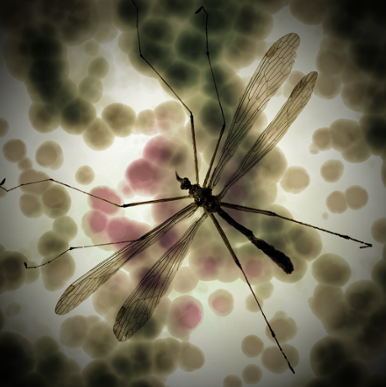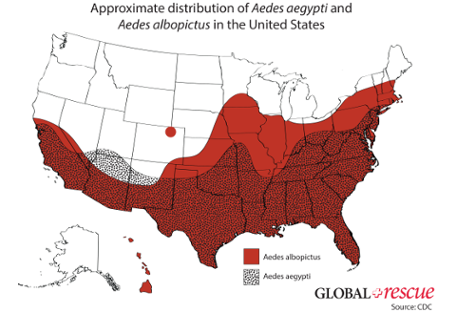There have been no documented cases of mosquito-borne transmission of Zika virus in the continental U.S. However, cases have been confirmed in people who have traveled to Zika-infected countries or acquired it through sexual transmission. According to the Centers for Disease Control and Prevention (CDC), between January 1, 2015 and March 30, 2016, at least 312 cases of travel-related Zika virus have been confirmed in the U.S., with the highest number of cases reported in Florida (74), New York (46), Texas (27) and California (17).
What areas are more susceptible?
Although it is impossible to predict whether the virus will spread to mosquitoes in the U.S., sporadic small-scale outbreaks of dengue and chikungunya — similar tropical mosquito-borne diseases spread by the Aedesmosquito — have been reported in the past in south Florida and southern Texas. Some cities in the southeastern and eastern coastal regions of the U.S. might be more prone to Zika transmission due to established populations of Aedesmosquitoes. However, in order for local transmission to take place, the Zika virus would need to be introduced by an infected traveler or infected mosquitoes and become sustained in an established population of Aedesmosquitoes.
According to a National Institute of Health (NIH) study, about 200 million citizens — more than 60% of the U.S. population — reside in areas of the U.S. conducive to the spread of Zika virus during summer months due to the presence of Aedes mosquitoes. At least one of the two Zika spreading mosquitoes are found in 38 states from California, southeast to Florida, and northeast to Maine (see map below). The southern and southeastern regions of the U.S. from California along the Gulf Coast and up the eastern coast to Connecticut contain both the Aedes aegypti and the Aedes albopictus mosquitoes.
What conditions make Zika favorable?
Both the Aedes aegypti and the Aedes albopictus species of mosquitoes are known to spread Zika. The two species need warm and relatively stable temperatures to survive and standing water to reproduce.
Meteorological conditions favorable for the Aedes mosquitoes are not present in the U.S. during winter months from December to March, except for south Florida and southern Texas. However, weather conditions become more suitable for Aedes mosquitoes during peak summer months from July to September.
A March 2016 study conducted by the National Center for Atmospheric Research (NCAR) and the University Corporation for Atmospheric Research (UCAR) simulated climate data and other information such as mosquito populations, air travel from Zika-affected countries, and poverty to investigate the likelihood of Zika spreading in 50 U.S. cities.
According to the study, by mid-July meteorological conditions in southeastern cities will be suitable for “high abundance” of the Aedes, eastern cities will be suitable for “moderate to high abundance” and cities in western U.S. are suitable for “low to moderate abundance.” Cities most at risk are Miami, Orlando, Savannah and Charleston. Cities with moderate risk are New York, Philadelphia, and Washington, D.C.
What will help?
Public health experts say any outbreaks are expected to be small and short-lived due to the vastly different conditions from countries experiencing widespread transmission.
Many countries experiencing a rapid spread of Zika are poorer and lack adequate public health response capabilities, limiting their abilities to contain and combat the virus. For instance, in countries where air conditioning is not commonly used and/or screens are not widely used on windows and doors, people are exposed to open air (and mosquitoes) for longer periods of time, allowing the virus to spread more easily.
Conversely, in the U.S., well-built homes, screened windows, air conditioning and access to mosquito preventative products are likely to limit or even prevent the spread of the virus.

What else should I know about Zika virus?
Zika virus is an acute viral illness primarily transmitted through the bite of an infected Aedes species mosquito that has previously fed on a person infected with the Zika virus. Zika can also be transmitted from mother to fetus, through blood transfusion, and through sexual contact.
The most common symptoms of Zika are fever, rash, joint pain and conjunctivitis. However, symptoms are usually mild and only last from several days to a week. About 80% of people infected do not experience symptoms. There is currently neither a vaccine nor a cure.
Prior to 2015, local transmissions of Zika virus had largely been confined to Africa, Southeast Asia and the Pacific Islands. Zika was first discovered in Uganda in 1947 and only 14 cases were confirmed from 1947 to 2007, all of which occurred in West Africa and South Asia. In 2007, the first outbreak was reported in Oceania when more than 185 cases were confirmed in the Yap Islands, an island chain in the Federated States of Micronesia. The virus then appeared in October 2013 in French Polynesia.
In May 2015, an outbreak of the virus began in Brazil and by April 2016, 34 countries and territories in the Americas reported local transmission of the virus. The recent outbreak of Zika has been strongly linked to birth defects, including microcephaly, an abnormal smallness of a newborn’s head associated with incomplete neurological development. The incidence of Zika has also been correlated to an increase in cases of Guillain-Barré syndrome, a syndrome in which the body’s immune system attacks part of the peripheral nervous system, causing paralysis.
In May 2015, the Pan American Health Organization (PAHO) issued an alert regarding the first confirmed Zika virus infection in Brazil and in February 2016, the World Health Organization (WHO) designated the Zika virus as a global public health emergency requiring a coordinated response, placing the disease in the same category of concern as Ebola. It is expected that Zika virus transmission will increase throughout the region increasing the incidence of infection in returning travelers and the possibility of local transmission in the U.S.
To stay up to date on Zika virus developments, contact us at 617-459-4200 or memberservices@globalrescue.com









